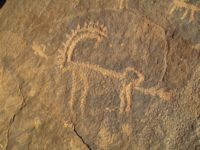This section provides the visitor with the content and background for the subjects in the petroglyphs, such as humans, animals, and plants. It also provides interpretations of complex scenes that incorporate many figures that together convey an event. The scenes mostly depict activities relating to hunting and warfare. In this section, the visitor will learn about the people who created the rock art of Saudi Arabia and their environment.
Subjects & Scenes
Examples:
-
Onager or African Wild Ass
The wild equine that is depicted in Arabian rock art could have been either the African wild ass (Equus africanus) or the Near Eastern onager, (E. hemionus). Until adequate skeletal remains are found in archaeological sites this question remains open. It is possible that both species occurred in different regions of the Arabian Peninsula. The onager is definitely [...]
-
Arabian Oryx
Oryxes are most easily recognized by their prominent horns, which range in length from 480-700 mm. There is little difference in size of the horns of males vs. females. The long, fairly straight horns are basically in line with the straight facial profile, but curve backward slightly. They are annulated, meaning that the horns possess a series of raised rings wrapping around them in [...]
-
Ostrich
The ostrich is the largest living bird, lays the largest egg of any living avian species, and has the largest eyes of any terrestrial vertebrate. Ostriches are in the same order, Struthioniformes, with the other flightless living species, kiwis, rheas, emus, cassowaries, and the extinct moa and elephant bird.
-
Ibex
The ibex is similar to the wild goat in terms of the shape of its head, body, and tail. Like the goat, it has scimitar horns that curve backward in a large semi-circle, but with the addition of a series of regularly spaced transverse ridges along the outer edge of the curve. Ancient artists depicted these ridges distinctly on the more realistic panels, however, where a caprine [...]



